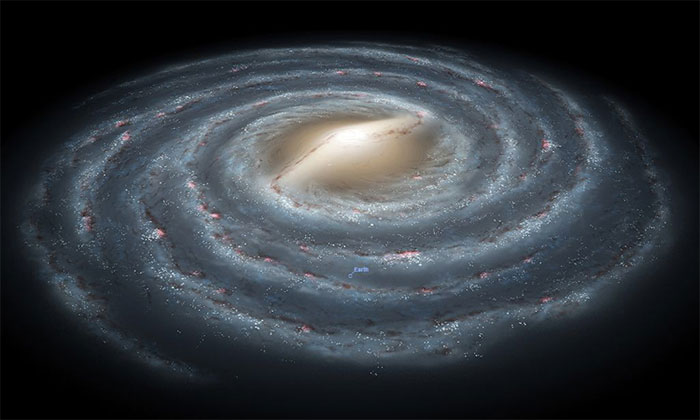The Milky Way may be 1.9 million light-years wide
By finding the edge of the Milky Way, scientists can more accurately calculate its mass and the number of small galaxies surrounding it.
Alis Deason, an astrophysicist at Durham University in the UK, and his colleagues try to determine the edge of the Milky Way, Science News reported on March 23. Their models indicate that the Milky Way galaxy has a diameter of 1.9 million light years, which is less than 0.4 million light years.

The diameter of the Milky Way galaxy could reach nearly two million light-years.(Photo: Space Answers).
The galactic disk , which holds the Sun and is also the brightest region of the Milky Way, is about 120,000 light-years wide. In addition to the galaxy disk is a disk of gas . A giant halo of dark matter filled with invisible particles covered both disks and spread out into space. However, the dark halo does not emit light, so scientists have difficulty measuring its diameter.
To find the edge of the Milky Way , a team of computer modeling experts on the formation of giant galaxies similar to the Milky Way. They focused on cases of two huge galaxies close together, like the Milky Way and Andromeda "neighbors" , because their gravity interacts with each other. The model shows that, just outside the edge of the halo of the giant galaxy, the surrounding small galaxies significantly reduce the velocity of travel.
Thanks to data from the telescope, Deason and colleagues found that small galaxies near the Milky Way also slowed down similarly. This happens at a distance of 950,000 light-years from the center, indicating that this is the edge. The edge of the Milky Way is 35 times farther from the center than the Sun.
In the future, astronomers will locate the edge of the Milky Way more accurately when more small galaxies are found around them. They may also look for distant stars near the edge of the Milky Way, according to Mike Boylan-Kolchin, astrophysicist at the University of Texas Austin.
New research helps astronomers better understand the characteristics of the Milky Way. For example, the larger the Milky Way, the larger the mass and the more galaxies it orbits, according to Rosemary Wyse, an astronomer at Johns Hopkins University. Scientists have found about 60 satellite galaxies of the Milky Way, but argue that the actual number is much larger.
- What is the Milky Way? What is the difference between a galaxy and a galaxy?
- The Milky Way's black hole may have erupted into a giant bubble of gas
- Enjoy the pure Milky Way season
- Discovery of the mysterious 'galaxy wheel' near the Milky Way Milky Way
- Discovered the galaxies about 10,000 million light-years from Earth
- The supermassive black hole exploded 300,000 years at the beginning of mankind
- The fastest star in the Milky Way
- Announcing the new map of Milky Way 187 million pixels
- How long does it take to traverse the vast Milky Way with the speed of light?
- The magnetic field around the galaxy is 80,000 light-years wide
- The Milky Way might contain 100 million black holes
- Detecting extremely dark dark networks
- The Milky Way had 'devoured' another galaxy billions of years ago
- The 'lonely star' was kicked out of the Milky Way, forever in nothingness
 Van Allen's belt and evidence that the Apollo 11 mission to the Moon was myth
Van Allen's belt and evidence that the Apollo 11 mission to the Moon was myth The levels of civilization in the universe (Kardashev scale)
The levels of civilization in the universe (Kardashev scale) Today Mars, the sun and the Earth are aligned
Today Mars, the sun and the Earth are aligned The Amazon owner announced a secret plan to build a space base for thousands of people
The Amazon owner announced a secret plan to build a space base for thousands of people